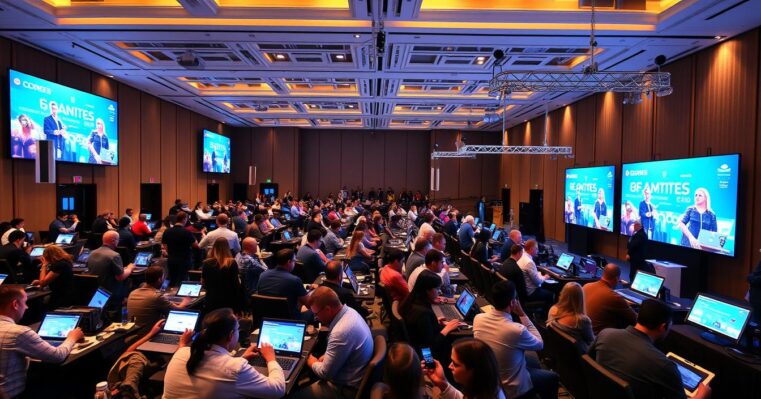Technology has become key in modern conferences, changing how they are planned and run. It keeps evolving to meet the needs of both attendees and organizers1. Today, conferences are vital for sharing knowledge, building relationships, and driving innovation. Technology plays a big role in making these events successful1.
Technology has made conferences more interactive, engaging, and efficient. Tools and platforms like Slot Demo have received 8,968,900 ratings, showing high interest2.
New innovations and advancements in conference technology are always coming. For example, Green Technology for Future 4.0 Community and Environment was the focus of Vol. 1 No. 2 (2023)3. Technology has improved communication, engagement, and accessibility. It makes it easier for attendees to interact with each other in a secure and user-friendly environment2.
Technology has also made virtual and hybrid events popular. The high-level conference in Japan in 1990, for example, brought together over 20 countries to discuss science and technology implications for international peace and security1.
Key Takeaways
- Technology in Conferences is a crucial aspect of modern events, with conference technology trends continuously evolving to meet the needs of attendees and organizers.
- The use of technology in conferences has made events more interactive, engaging, and efficient, with various tools and platforms available to enhance the overall experience.
- Conference technology trends are constantly changing, with new innovations and advancements being introduced regularly.
- The integration of technology in conferences has improved communication, engagement, and accessibility, making it easier for attendees to participate and interact with each other.
- Technology in Conferences has also enabled the creation of virtual and hybrid events, which have become increasingly popular in recent years.
Introduction to Technology in Conferences
Technology has changed how we hold and experience conferences. Digital event solutions make them more engaging, efficient, and open to everyone. Studies show that using new tech like virtual reality, event apps, and better registration systems helps a lot4.
Technology brings many benefits to conferences. It helps people work together better, makes the event more enjoyable, and makes it easier for everyone to join. For example, digital maps help people find their way around, making the event more fun and interactive4. Also, games at events make people more involved and happy, leaving them with great memories4.
Here are some ways technology is used in conferences:
- Virtual and augmented reality experiences
- Event apps and mobile solutions
- Advanced registration and ticketing systems
- Digital floor plans and event diagramming tools
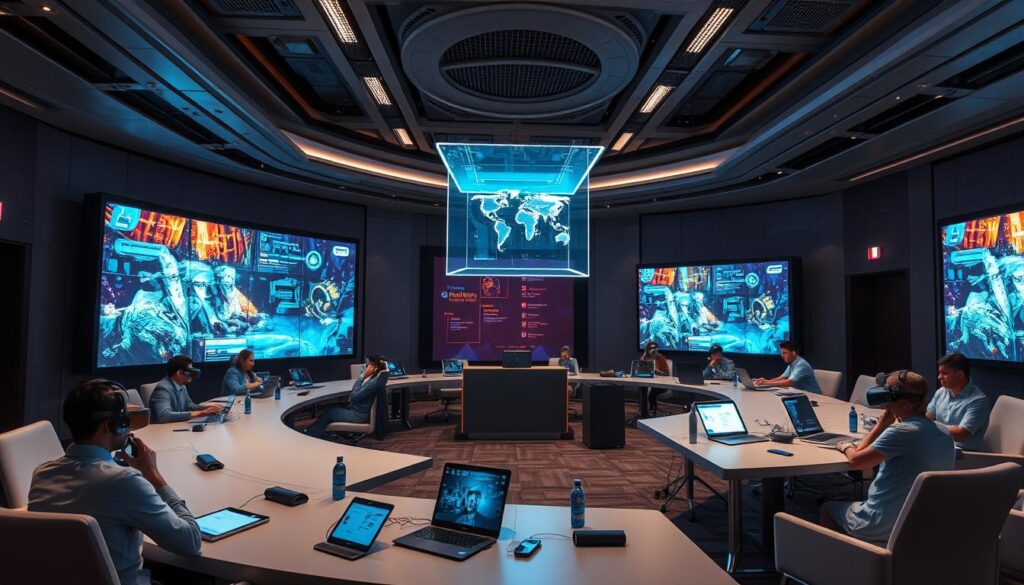
Using technology in conferences makes the experience better for everyone. As tech keeps getting better, we'll see even more cool things at future events4.
Types of Technology Used in Conferences
Conferences are key in many industries today. Thanks to conference tech tools, they're more efficient and fun. Audio-visual equipment like top-notch sound systems, HD displays, and interactive screens are crucial. They make presentations better and get the audience more involved, making the event more engaging.
Event management software is also vital. It makes planning, registration, and scheduling easier. This software helps organizers work better, reducing their workload and mistakes5. shows video conferencing can handle up to 25 people at once, depending on the software.
Virtual conferences are also gaining popularity, allowing people to join from anywhere. This is great for those who can't make it in person. Virtual reality experiences make these events more interactive and memorable6. mentions Eventbrite supports over 800,000 event creators with digital tools and tech integrations.
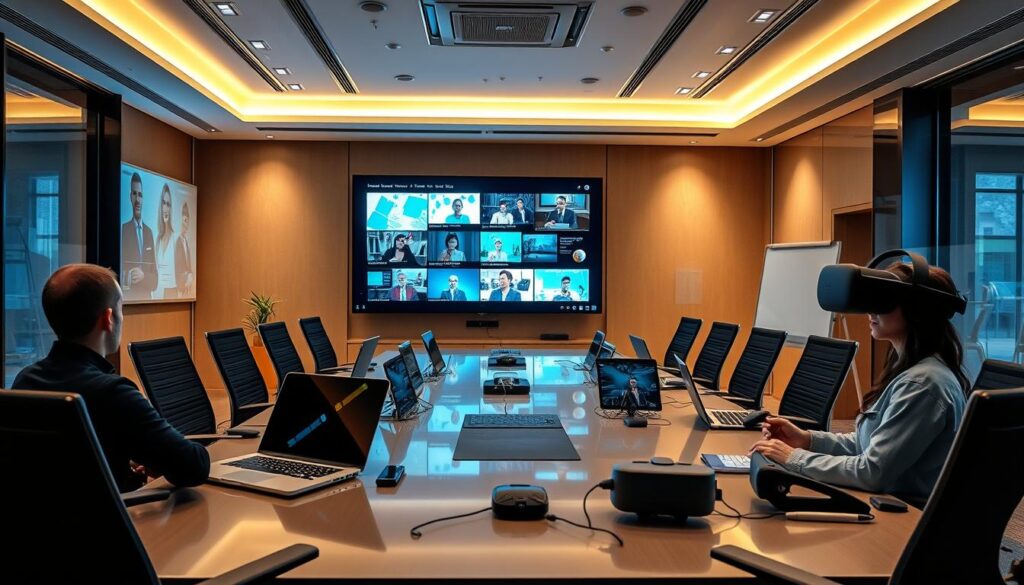
Technology in conferences brings many benefits. It boosts engagement, makes events more accessible, and improves communication. With conference tech tools, organizers can create more engaging experiences. This leads to happier attendees and more value from the event. As technology evolves, staying updated with trends like virtual reality and event management software is key to a better conference experience.
Benefits of Technology in Conference Settings
Technology has changed how we organize and attend conferences. It makes events more engaging, accessible, and efficient. Engineering conferences, for example, use tech to help engineers grow professionally7.
Interactive displays, voting systems, and feedback tools are key. They encourage people to get involved and make events more fun and interactive.
Technology also boosts engagement at conferences. Tools like Microsoft Teams, Zoom, and Webex8 allow for virtual participation. This includes features like virtual hand-raising and real-time polls.
It also makes events more accessible. People can join from anywhere and tools help those with disabilities9.
Technology also improves communication at conferences. It helps capture and share information efficiently8. Modern tools allow for sharing files and screens in real time, aiding in collaborative work8.
The global market for conference room solutions is expected to grow to USD 6,068.1 million by 20339. This shows technology's crucial role in the future of conferences.
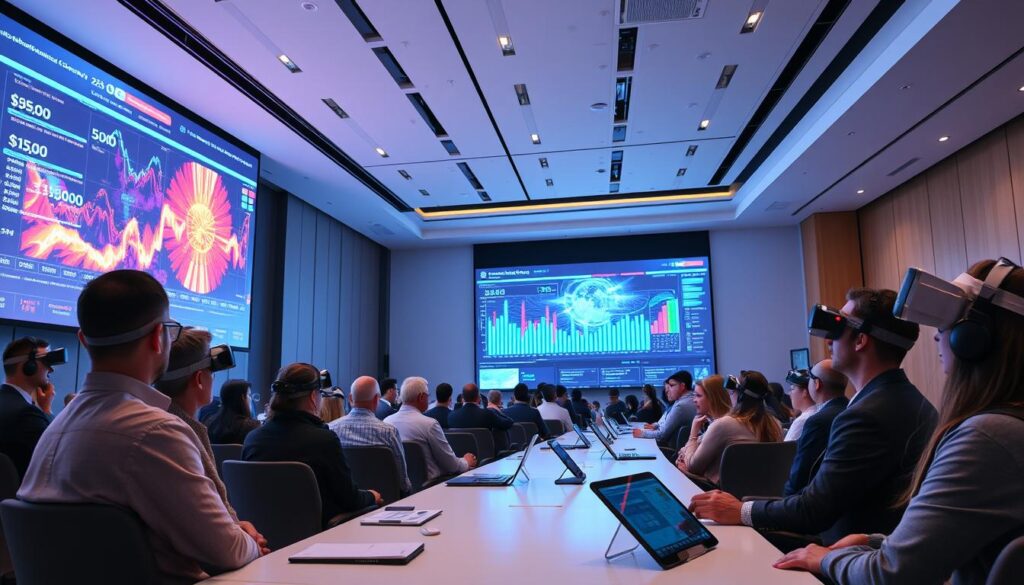
| Benefits of Technology | Description |
|---|---|
| Enhanced Engagement | Interactive displays, voting systems, and real-time feedback tools |
| Improved Accessibility | Remote participation and tools for attendees with disabilities |
| Streamlined Communication | Meeting transcription services, translation services, and file-sharing capabilities |
Virtual Conferences: A Growing Trend
Virtual conferences are now more popular than ever. They offer a convenient and cost-effective way to connect with people worldwide. With digital event solutions on the rise, hosting a successful virtual conference is easier than before. In fact, 77% of organizations use video conferencing for business needs10.
Virtual conferences have many benefits. They save on travel costs and make it easier for more people to attend. Travel expenses have fallen by 30% thanks to video conferencing11. They also offer interactive features like live Q&A sessions and virtual networking lounges.
Popular platforms for virtual conferences include Zoom, Google Meet, and Skype. These platforms have features like video conferencing, screen sharing, and instant messaging. When picking a platform, consider ease of use, compatibility, and security12.
Here are some benefits of virtual conferences:
- Increased accessibility and reach
- Reduced travel expenses and environmental impact
- Improved engagement and interaction
- Enhanced security and data protection
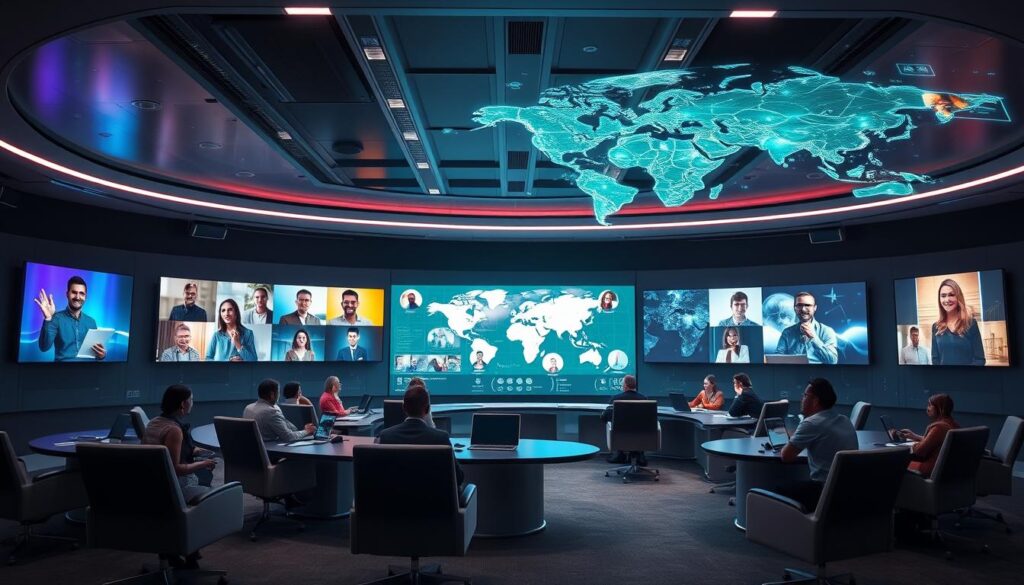
Hybrid Conferences: Combining the Best of Both Worlds
Hybrid conferences are now more popular than ever. They mix in-person and virtual parts, thanks to hybrid event technology. This way, they can reach more people and fit different needs13. With Technology in Conferences, organizers make sure everyone has a great experience, whether they're there in person or online.
Hybrid events use top-notch video tech and tools like Zoom or Teams13. This makes talking and hearing clear, so everyone can join in. They also offer great amenities, like comfy spaces and tasty food13.
There are many good things about hybrid events. For example, 87% of people are okay with using tech at live events14. Also, 86% of B2B groups make money from their hybrid events in 7 months14. Using hybrid event technology and Technology in Conferences helps make events fun and useful for all.
In summary, hybrid conferences are a smart mix of old and new. They offer a flexible and fun experience for everyone. By using the latest Technology in Conferences and hybrid event technology, organizers can host memorable events13.
Smart Event Solutions
Technology is changing how we hold conferences, making things easier and more efficient. With tech tools, event planners can automate tasks and cut down on mistakes. This lets them focus more on creativity.
Event apps are key in this change. They give attendees their own schedules, help them network, and keep them updated in real-time15.
Using tech tools brings many benefits. For example, they make registration smoother, offer live data, and use AI for better experiences15. They also help exhibitors and sponsors by giving them data to improve their results16.
Event platforms can also boost attendance. They offer activities before and during events, and keep people engaged after15.
When making event apps, it's important to think about everyone involved. By tailoring solutions, planners can make events unforgettable and boost their return on investment17. Features like personalized agendas and networking tips are crucial. With the right tools and apps, events can be more engaging and successful15.
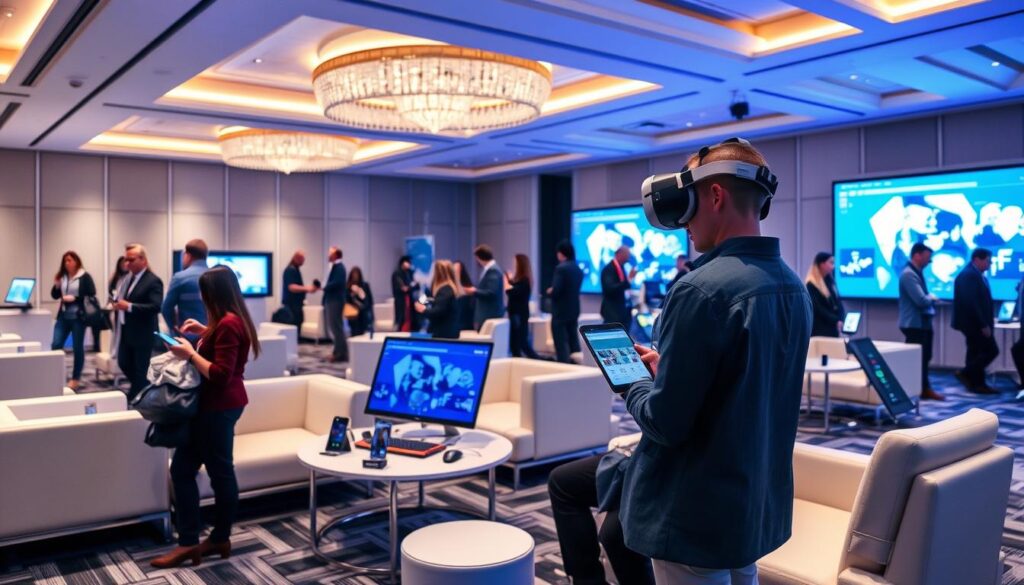
Networking Opportunities Facilitated by Technology
Technology has changed how people connect at conferences. Digital tools help attendees make meaningful connections. They use data analytics and AI to understand what people want18.
Digital tools like AI matchmaking and digital business cards make networking easier19. Virtual roundtables offer a chance to connect in big events. They work best with good Wi-Fi, charging stations, and attendee lists20.
Apps like Agorify let attendees create profiles, plan meetings, and chat live19. This makes it easy to talk and set up meetings. Technology helps make conferences better for networking, with fun activities and social media20.
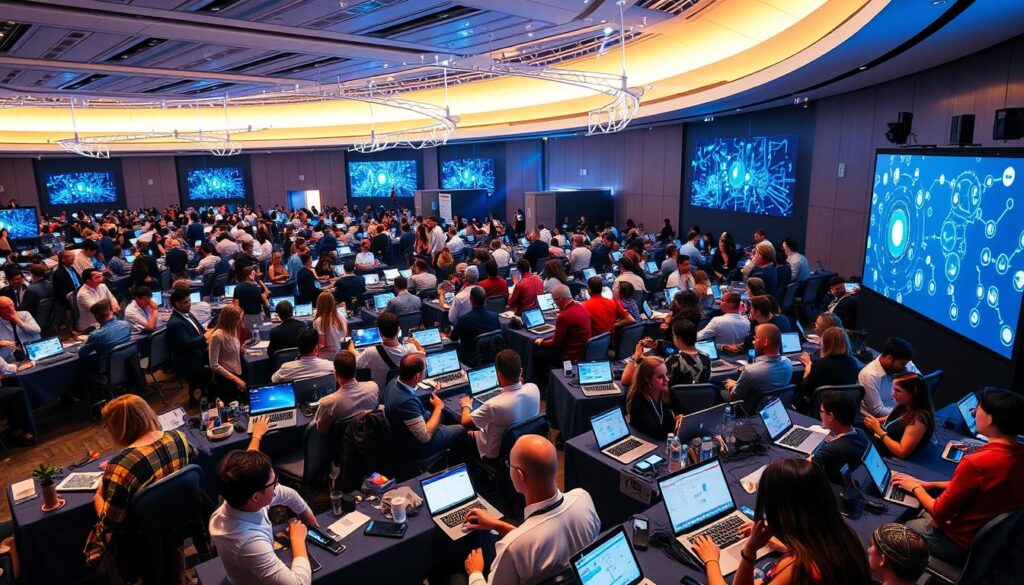
Technology has made networking at conferences better. It gives people more chances to connect and share experiences. With digital tools, organizers can make events more engaging, leading to deeper connections18.
The Role of Social Media in Conference Promotion
Technology has changed how we promote and experience events. Social media is key in boosting event engagement. Platforms like Instagram, LinkedIn, Facebook, and Twitter are used to promote events21. They also help live stream conferences to a global audience, enhancing communication and engagement21.
Attendees often turn to social media for event info. 96% use LinkedIn, 93% Facebook, and 79% YouTube before an event22. Email marketing is also effective, targeting specific groups and building excitement for events21. To engage on social media, organizers can use hashtags, live tweets, and social media walls.
Using social media for promotion has many benefits:
- It increases engagement and interaction with attendees
- It improves communication and accessibility
- It enhances event promotion and marketing
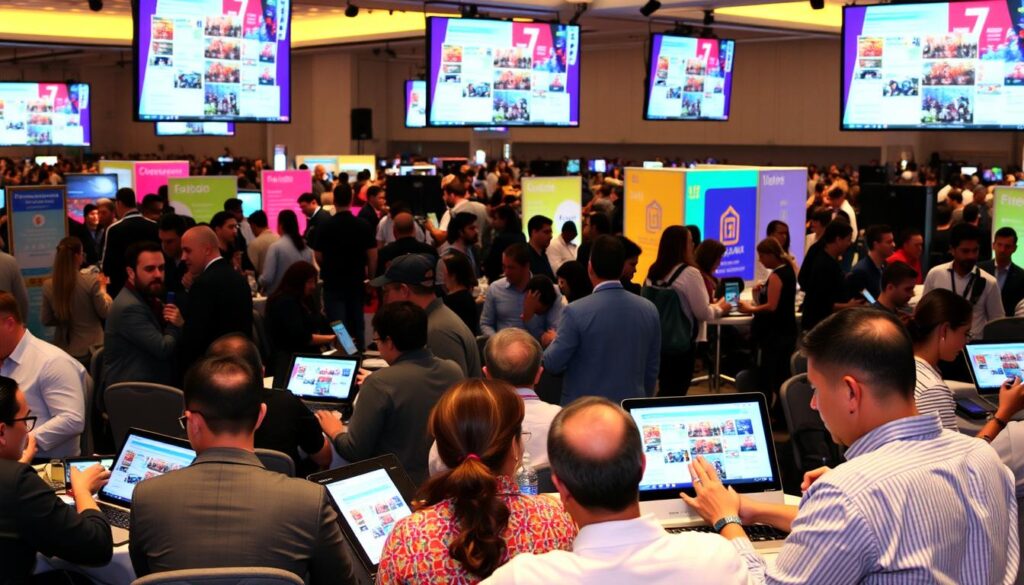
By using social media and technology, event organizers can create a more immersive experience. Live streaming allows events to reach more people, offering remote access beyond the physical event space21.
Data Analytics and Its Impact on Conferences
Technology has changed how conferences are run. Now, event planners can see how attendees feel, what sessions are hit, and who shows up in real-time23. This info helps them see if the event was a success and how to make the next one better. Trends in conference tech are moving towards using data to make events more personal and effective23.
Data analytics brings big benefits to planning conferences. It helps understand the audience better, predict what will happen, and make things run smoother23. By looking at who comes and how they interact, planners can make their marketing better and make the event more enjoyable. It also helps spot problems and guess how many will come, guiding decisions24.
Tools like event apps, surveys, and social media analytics collect this data23. They give insights into what attendees like and don't, helping planners make smart choices. Using data, organizers can make events more engaging and personal, leading to a better experience for everyone.

Security Considerations in Conference Technology
Security is key in Technology in Conferences. With digital events on the rise, keeping attendee data safe is crucial. Studies show 11 tips for secure remote meetings25. This includes avoiding software vulnerabilities like remote code execution and denial-of-service attacks25.
Video conferencing security is also vital. This includes setting meeting rights, using waiting rooms, and encrypting meetings25. It's important to let attendees know if a meeting is being recorded25. Video conferencing has become a must for businesses, thanks to remote work26.
To stay safe, make meetings private, update software, and teach users about phishing26. Companies are using video conferencing due to social distancing and COVID-1927. Many services let hosts password-protect meetings to keep only invited guests out27.
The following table highlights some key security considerations for Technology in Conferences:
| Security Measure | Description |
|---|---|
| Encryption | Protects data from unauthorized access |
| Unique Meeting IDs | Prevents unauthorized access to meetings |
| Meeting Passwords | Ensures only authorized attendees can join |

By following these best practices, Technology in Conferences can be safe and effective252627.
Case Studies: Successful Tech-Driven Conferences
Technology has changed how we organize and enjoy events. Tools like virtual platforms and apps make conferences more engaging. For example, a big international conference used both online and in-person parts. This move led to more people joining from all over the world28.
A local industry event also showed the power of tech. It used apps for live interaction, boosting participation and interest29. This shows how important tech is for making events a hit.
Some key tech used includes virtual platforms, event apps, and tools for engaging the audience. It's key for event planners, tech providers, and tech experts to work together28. With these tools, events can make attendees happier, more involved, and provide valuable data for future events.
In summary, using tech in conferences can greatly improve the experience. By studying successful events and using the right tech, organizers can create memorable and engaging events for their guests30.
Future Trends in Conference Technology
The event planning world is changing fast, and conference technology trends are leading the way. Now, conferences are more immersive and interactive. They use AI for personal touches and holographic tech for remote speakers.
Blockchain is making ticketing and ID checks safer31. And 5G networks will make connections faster and more stable31. It's also key to think about making events green and accessible, as 78% of people care about this32.
Here are some trends to look out for in the future:
- More virtual and augmented reality for deeper experiences
- Focus on making events sustainable and accessible
- Advanced data tools and AI to improve the event
As things change, it's crucial to keep up with new tech in conferences. This ensures events are fun, eco-friendly, and open to everyone32.
Challenges in Implementing Conference Technology
Implementing tech in conferences comes with its own set of challenges. Technical problems like connectivity issues and software compatibility can really slow things down33. Also, some people might not want to change, whether they're organizing or attending34.
Common tech problems include bad audio, poor sound quality, and messy cables33. These can mess up meetings and even be dangerous. Plus, issues with room scheduling and device connectivity can cause delays33. To fix these, it's key to test everything well, train everyone, and show the value of new tech34.
Using a Conference Management module can help a lot, making things smoother and faster34. Also, looking at how sessions go and what people say can help make future events better34. By tackling these problems and using tech wisely, organizers can make sure everyone has a great time.
- Providing thorough training to staff and attendees on new technologies
- Conducting thorough testing of all technical equipment
- Encouraging feedback from attendees to identify areas for improvement
By using these strategies and knowing the challenges, organizers can host a successful and fun event. This event will show off the good things about tech in conferences34.
| Challenge | Solution |
|---|---|
| Technical issues | Thorough testing and training |
| Resistance to change | Demonstrating benefits and providing support |
| Inefficient room scheduling | Using a Conference Management module |
Integrating Sustainability with Technology
The world is getting greener, and so are conferences. Using tech can cut down on carbon emissions from events. Digital tools help a lot in this area35. For example, event apps with digital maps let people move around easily, cutting down on paper and waste35.
Adding virtual parts to events, like hybrid or online-only, also helps the planet. It means less travel, which is good for the environment35. Companies like Julia Charles Event Management make sure events are both memorable and green from the start35. They use a framework called Technology Readiness Levels (TRL) to check if new tech is ready for use36.
Here are some ways to make conferences greener with tech:
- Choose energy-saving gear and green energy sources
- Go for eco-friendly food and plan menus to avoid waste
- Use virtual reality and other tech to make experiences more real without needing lots of stuff
These steps can make conferences better for the planet. By using digital tools and tech, we can have greener, more fun events for everyone35.
Conclusion: Embracing Technology in Future Conferences
Technology has become key in modern conferences, moving from a nice addition to a must-have. It helps with communication, engagement, and making events more accessible. It also uses data to improve how we experience conferences37.
As we look to the future, conference planners need to keep up with new tech. Things like the Internet of Things and Artificial Intelligence will change how we plan and run events37. We'll see more focus on being green and using eco-friendly solutions37. This will make conferences more engaging and meaningful for everyone.
Ready to bring the latest in conference tech to your events? The team at Alcor Prime38 is here to help. We specialize in smart computing and green solutions. Let's work together to make your events unforgettable38. Reach out at +62 21 8322 997 or hello@alcorprime.com to start planning the future of conferences.
FAQ
What is the role of technology in modern conferences?
Technology is key in today's conferences. It makes events more interactive and engaging. Now, we have digital tools that improve how we communicate and connect.
What are the key areas where technology is making the biggest impact in conferences?
Technology is changing how we communicate, engage, and access events. It makes things more efficient and enhances the attendee experience. It also allows for remote participation.
What types of technology are commonly used in conferences today?
Conferences use many technologies. This includes advanced audio-visual tools, event management software, and virtual reality. These tools change how we present, plan, and learn.
How does technology enhance engagement and participation in conferences?
Technology makes conferences more interactive. It includes live polls and Q&A sessions. This turns attendees into active participants, not just listeners. It also makes events more accessible for everyone.
What is the rise of virtual conferences, and how do they compare to traditional in-person events?
Virtual conferences are becoming more popular. They offer global reach and cost savings. But, they also face challenges compared to in-person events.
What is a hybrid conference, and what are its key features?
Hybrid conferences mix in-person and virtual elements. They offer a seamless experience for all participants. This approach makes events more flexible and accessible.
How are innovative smart solutions transforming the conference experience?
Smart solutions like mobile apps and gamification are changing conferences. They help create personalized experiences and improve networking. This leads to happier attendees and better learning outcomes.
How is technology revolutionizing networking at conferences?
Technology is changing how we network at conferences. It includes digital tools like AI-powered matchmaking. These tools help make meaningful connections, even in big events.
What role does social media play in promoting and enhancing conferences?
Social media is vital for promoting and engaging with conferences. It helps spread the word, stream live, and build a community. This makes events more accessible and engaging.
How can data analytics help improve conference planning and execution?
Data analytics is key for measuring and improving conferences. It helps organizers understand what works and what doesn't. This way, they can tailor the experience for everyone.

